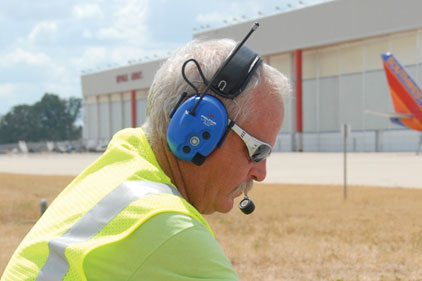One of the challenges faced by supervisors and site health and safety professionals is overcoming worker objections to using hearing protection. Let's look at three common worker objections and how technology advancements can help overcome these objections to gain improved worker acceptance and program compliance.
Objection #1: Hearing protection may interfere with on-the-job communication
New wireless and radio communication technologies are making it easier to combine hearing protection with effective communication. These products help companies address one of the most common concerns of workers: the possibility that hearing protectors may interfere with communication on the job.
Companies have more options than ever for pairing radio systems with hearing protectors. One innovative solution is a compact in-the-ear headset that can be connected to a wide variety of two-way radio systems. For workers who wear full-facepiece respirators, hoods and helmets, these lightweight devices are easier to use than earmuff-style headsets.
New technology is also available to enhance face-to-face and mobile phone conversations. Level-dependent microphones allow the listener to hear conversation and warning signals in the immediate area. Wireless Bluetooth™ technology makes it easy to connect with mobile phones and MP3 players without removing hearing protectors.
Finally, headsets with built-in two-way radios allow employers to improve communication in noisy areas where external two-way radios are not in use.
Objection #2: Fitting hearing protection
Another common worker objection to using hearing protectors is uncertainty in how to fit earplugs. Recent studies of earplug fitting indicate that as many as 30-40 percent of workers may be obtaining inadequate protection from their earplugs. Possible causes are insufficient training on fitting methods, failure to follow fitting instructions, and wearing devices that are not the proper size for the employee’s ears.
More companies are turning to easy-to-use, portable fit testing systems to identify which workers are fitting and wearing earplugs correctly and those who need a different type of hearing protector or need to be re-trained. OSHA, NIOSH and the National Hearing Conservation Association (NHCA) have endorsed hearing protector fit testing as a best practice.1
The fit testing method known as Field Microphone in Real-Ear (F-MIRE) allows employers to measure the noise reduction provided by the hearing protector directly and objectively, without the need for the employee to listen or respond to the test signals. With F-MIRE technology, it takes only seconds to measure the noise reduction at seven different frequencies in each ear and to calculate an overall performance rating for each employee, known as the Personal Attenuation Rating or PAR.
Companies often provide only one size earplug for all employees when they should be offering two or three sizes and different types of earplugs. Finding the right size and type of earplugs for each worker is easier when it is done as part of an earplug fit testing program. In addition, many workers demonstrate improved fitting technique after completing a fit testing session.
Another solution is to offer easier-to-fit hearing protectors, such as earmuffs and push-to-fit earplugs that do not need to be rolled down before fitting in the ears. For workers with dirty hands and those who wear gloves, these devices simplify the fitting process and allow them to put their hearing protection on without having to remove their gloves or wash their hands.
Objection #3: Compatibility with other personal protective equipment (PPE)
Many workers wear hearing protection in addition to other PPE such as eyewear, hard hats, respiratory protection, and welding helmets. New technologies and PPE options that integrate protection for multiple types of hazards are offering new solutions for employers. For workers who need to wear hearing protection along with eyewear, companies can choose eyewear with a cord control feature designed to keep a corded earplug attached, untangled and ready for use. New technologies are also enabling thinner, more flexible eyewear frames, which help minimize the gaps between earmuff cushions and the head. This helps to reduce loss of attenuation and improve wearer comfort.
For workers who also need respiratory protection, integrated solutions are now available that incorporate respiratory protection, hearing protection, head protection and eye protection into one streamlined product. These multi-protection products can bring other benefits as well, including enhanced wearer comfort and reduced downtime adjusting PPE. Other advancements include innovative, compact in-the-ear headsets which can be connected to a wide variety of two-way radio systems without interfering with respiratory protection.
Newer earmuff styles with innovative neckbands and slim cup designs are helping improve PPE compatibility for workers who use welding helmets or faceshields. Finally for hard hat wearers, cap mounted earmuffs offer a solution for workers who prefer to wear earmuffs. Newer styles make it quick and easy to attach earmuffs to hard hats.




